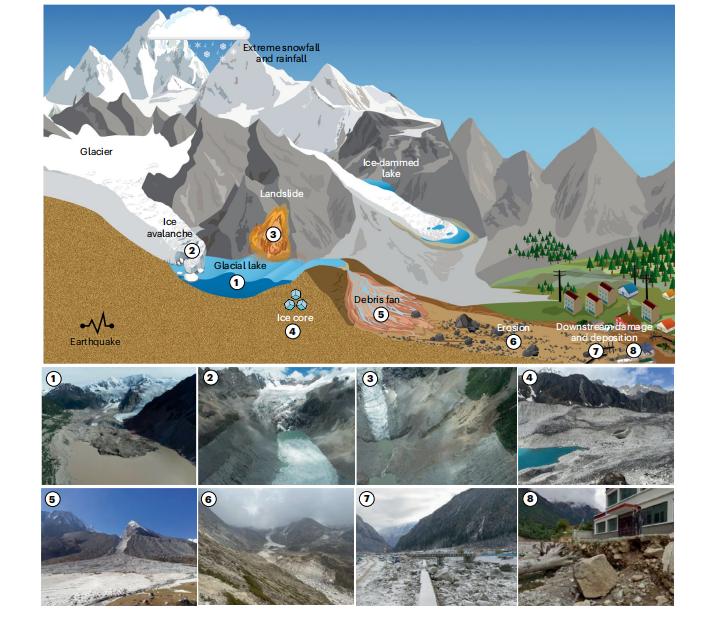Global glacier mass loss has accelerated, producing more and larger glacial lakes. Many of these glacial lakes are a source of glacial lake outburst floods (GLOFs), which pose threats to people and infrastructure. In this Review, we synthesize global changes in glacial lakes and GLOFs. More than 110,000 glacial lakes currently exist, covering a total area of ~15,000 km2, having increased in area by ~22% dec–1 from 1990 to 2020. More than 10 million people are exposed to the impacts of GLOFs, commonly associated with dam failure or wave overtopping associated with mass movements. Although data limitations are substantial, more than 3,000 GLOFs have been recorded from 850 to 2022, particularly in Alaska (24%), High Mountain Asia (HMA; 18%) and Iceland (19%), the majority (64.8%) being from ice-dammed lakes.
Recorded GLOFs have increased in most glaciated mountain regions of the world, with ongoing
deglaciation and lake expansion expected to increase GLOF frequency further.
In HMA, GLOF hazards are projected to triple by 2100, but changes in other regions
will likely be lower given topographic constraints on lake evolution.
Future research should prioritize acquiring field data on lake and dam properties,
producing globally coordinated multi-temporal lake mapping, and robust and efficient modelling
of GLOFs for comprehensive hazard assessment and response planning.

Glaciers have been losing mass since the end of the Little Ice Age, and at high — and accelerating — rates since the 1960s . Indeed, overall mass loss from glaciers and ice caps (excluding the Greenland and Antarctic ice sheets) totalled 267 ± 16 Gt year–1 from 2000 to 2019 , much of which can be attributed to anthropogenic arming .
When the resultant meltwater is naturally dammed (by ice, a moraine or bedrock), glacial lakes can form on (supraglacial), within (englacial), under (subglacial), at the edge of (ice-marginal) or beyond the front of (proglacial) glaciers. There are an estimated 14,394 of these lakes (>0.05 km2 ) globally , the majority of which are in Greenland, the Southern Andes, Antarctica and the Subantarctic, Alaska, Canada and High Mountain Asia (HMA) (Fig. 1a). The number and size of glacial lakes is generally increasing, especially for proglacial lakes, owing to close connections with contemporary glacier retreat and meltwater production at local, regional and global scales. However, there is considerable regional variability, including notable expansion in Alaska, Greenland periphery, Patagonia and HMA. Nevertheless, the overall growth pattern is expected to continue, in line with a projected 26–41% decrease in glacier mass by 2100 under temperature increases of 1.5–4 °C.
The stability and longevity of glacial lakes are highly variable. Glacial lakes can drain suddenly and very quickly (hours to days), releasing a glacial lake outburst flood (GLOF). More than 3,000 GLOFs have been reported worldwide from 850 to 2022(Fig. 1b), each with characteristic rapid rise to peak discharge and often very large flood volumes. For example, the 1996 volcanic eruption beneath the Vatnajökull ice cap, Iceland, produced an outburst flood with an estimated peak discharge of ~55,000 m3 s–1, thereby temporarily becoming the second largest river in the world after the Amazon. Indeed, ice-dammed lakes have produced some of the largest peak discharges recorded in human history, including peak discharges of >105 m3 s–1in HMA32 and 109 m3 s–1 in the Andes and laska.
Accordingly, GLOFs rank among the most prominent glacier hazards, killing thousands of people over the past century and causing extensive damage tens to hundreds of kilometers downstream. For instance, the 1941 GLOF in Huaraz, Peru, destroyed a third of the city and killed about 5,000 people36, and the 2013 GLOF in Kedarnath, India, killed more than 6,000 people. Given that millions of people are potentially at risk from GLOFs worldwide, especially in a warming climate, understanding the location, timing of formation, evolution and physical characteristics of glacial lakes is critical to mitigating the downstream impacts to communities and infrastructure.
In this Review, we synthesize glacial lake and GLOF hazard data sets from most glaciated regions of the world to assess their ongoing and projected changes. We begin by documenting the global and regional distribution of glacial lakes. We follow by assessing the characteristics and historical trends of GLOFs. We subsequently discuss future projections in glacial lakes and the corresponding GLOF hazard and risk, before ending with research priorities. Throughout, focus is on the physical aspects of glacial lakes and GLOFs in a warming world.
Sources:
NATURE
https://www.nature.com/articles/s43017-024-00554-w .
Provided by the IKCEST Disaster Risk Reduction Knowledge Service System
Comment list ( 0 )
